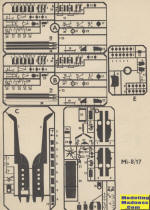
| KIT #: | 28 |
| PRICE: | $15.00 when new |
| DECALS: | Four options |
| REVIEWER: | Scott Van Aken |
| NOTES: | 1989 Release |

| HISTORY |
The Mil Mi-8 (Russian: Ми-8, NATO reporting name: Hip) is a medium twin-turbine helicopter, originally designed by the Soviet Union in the 1960s and introduced into the Soviet Air Force in 1968. It is now produced by Russia. In addition to its most common role as a transport helicopter, the Mi-8 is also used as an airborne command post, armed gunship, and reconnaissance platform.
Along with the related, more powerful Mil Mi-17, the Mi-8 is among the world's most-produced helicopters, used by over 50 countries. As of 2015, when combined the two helicopters are the third most common operational military aircraft in the world.
| THE KIT |
 This
kit by KP is quite popular with the reboxers, having appeared over the years in
Revell, SMER, Italeri, Mr.Kit and a number of other boxes. Generally, they have
different markings options, but that is about it. The kit will build either an
Mi-8 or an early Mi-17. The main difference being which side of the fuselage the
tail rotor is located. On the 8 it is on the right and with the 17 it is on the
left. Note also that the 17 has uprated engines so can handle more weapons on
the side pylons.
This
kit by KP is quite popular with the reboxers, having appeared over the years in
Revell, SMER, Italeri, Mr.Kit and a number of other boxes. Generally, they have
different markings options, but that is about it. The kit will build either an
Mi-8 or an early Mi-17. The main difference being which side of the fuselage the
tail rotor is located. On the 8 it is on the right and with the 17 it is on the
left. Note also that the 17 has uprated engines so can handle more weapons on
the side pylons.
Despite being developed when pretty much everyone else had gone to engraved panel lines, this one is of the raised variety. The kit has a fairly complete interior with a full cockpit (minus the collective, which seems endemic with older helo kits) and a cabin with jump seats along the side.
There are separate window sets for the cabin depending on if you are doing an Mi-8 or Mi-17. At this time you are to install the cockpit/cabin assembly and put weight under the cockpit. It seems like they ask for 3 grams, but I'd add more. You are also to build up the Mi-8 weapons pylons (assuming you want to use them). Next the upper engine assembly is constructed and attached along with the horizontal stabs. Note that the exhaust also differ between types.
The main rotor head is nicely done with straight blades. Then the Mi-17 weapons pylon assemblies are done. Moving back to the fuselage, the tail rotor, engine intakes and main landing gear are glued in place. This is followed by the tail rotor, nose gear and the cockpit clear pieces.
 Instructions
are a bit vague on some parts, such as the attachment of the weapons pylons, and
no detail drawings are provided to help. Interior color information is also
vague with no guide. Four markings options are provided and all are shown on the
back of the box. Two are Mi-8 and Two are Mi-17, Three are Czech aircraft. One
is a civilian plane where all the large areas will need to be painted. The
others are military planes in either green/brown or two shades of green. The
fourth is a Soviet aircraft for which there is no scheme provided. Fortunately,
there are a lot of images on the internet to help. Decals are nicely printed,
but have yellowed fairly badly and are best tossed in favor of aftermarket.
Instructions
are a bit vague on some parts, such as the attachment of the weapons pylons, and
no detail drawings are provided to help. Interior color information is also
vague with no guide. Four markings options are provided and all are shown on the
back of the box. Two are Mi-8 and Two are Mi-17, Three are Czech aircraft. One
is a civilian plane where all the large areas will need to be painted. The
others are military planes in either green/brown or two shades of green. The
fourth is a Soviet aircraft for which there is no scheme provided. Fortunately,
there are a lot of images on the internet to help. Decals are nicely printed,
but have yellowed fairly badly and are best tossed in favor of aftermarket.
| CONCLUSIONS |
| REFERENCE |
https://en.wikipedia.org/wiki/Mil_Mi-8
October 2022 Copyright
ModelingMadness.com. All rights reserved. No reproduction in part or in whole
without express permission from the editor. If you would like your product reviewed fairly and fairly quickly, please
contact
the editor or see other details in the
Note to
Contributors.